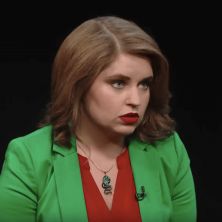Lawyer and expert Viktoriya Strakhova once worked at the side of the state: at first she was a project manager of the financial sector reforms, in 2016 she participated in the PrivatBank nationalization, and later she became corporate secretary of the already state PrivatBank.
Today she is in Volodymyr Zelenskyi’s team, being responsible for the banking sector. In her interview for the program ‘On Vono Jak’ Strakhova has stated that Kolomoyskyi did not steal any money from PrivatBank and suggested having a setoff between the government and the oligarch. That caused quite a resonance in the media.
VoxCheck is not the prosecutor’s office and not the court to make any conclusions as to somebody’s responsibility under the law. But we have managed to check some Strakhova’s statements for their reliability, contrasting them with information available in public access.
When did the IMF start talking about nationalization of PrivatBank ‘aloud’?
Nationalization of PrivatBank took place in December 2016. Strakhova assures that nationalization became the solution to the ‘PrivatBank problem’, which lied in Kolomoyskyi’s personality, his unpredictability. ‘He scares everyone away, in particular, foreign partners’, – Strakhova said. Here comes direct speech.
FALSE
That is why, when you read all the IMF documents carefully, the first mention of PrivatBank nationalization is available in the 2015 memorandums, at the beginning of the year.
4:44 – 4:57
FALSE
While at first they (the norms of the Memorandum between Ukraine and the IMF – ed.) presupposed vague fate of the then owners, the final memorandum of 2016 envisaged complete withdrawal of the then shareholders from PrivatBank.
7:57 – 8:09
Probably, Strakhova means some internal IMF documents (mentioning the memorandum with Ukraine, which is public). The Memorandum of July 2015 tells about stabilization of the banking system, no words like ‘nationalization’ or ‘PrivatBank’ or euphemisms like ‘systemic bank’ are there. Also, there is no memorandum of the early 2015, but only a March request made by Ukraine for cooperation, where even no ‘large systemic bank’ is mentioned.
The first mention of nationalization is available in the Memorandum of September 2016 – it prescribed what should be done in case of nationalization of a ‘large bank’. The document does not mention ‘PrivatBank’, but a certain systemic bank. It is clear, however, that PrivatBank is meant: as of 2016, the NBU determined three systemic banks in Ukraine, and Privat was the only non-state one back then.
In particular, the 2016 memorandum says:
In case of the bank’s nationalization a well-known recognized international company should be hired to manage the bank and to transform it into an attractive commercial project of the future. Besides that, 90 days after putting the bank under temporary administration at the latest the Ministry of Finance would draw up and publish the ‘Memorandum of Understanding’ with that bank within the periods fixed in paragraph 17 of the Memorandum. (page 12, paragraph 13.b)
Thus, nothing was mentioned about the non-specificity of the share of owners in Ukraine’s memorandums with the IMF.
Could hryvnia devaluation have led to a considerable decrease in the PrivatBank’s reserves?
MANIPULATION
Devaluation of the national currency, devaluation of the very assets in Ukraine led to the situation where credits were insufficiently reserved.
5.14 – 5.25
Hryvnia devaluation could really influence the bank capitalization to a certain extent. While the collateral under the credit prior to devaluation made up 8 thousand UAH, or $1 thousand at the exchange rate, after the devaluation these 8 thousand UAH made up $300. It appears that in such a situation the bank has to increase its reserves for such credits, since it is not fully collateralized. And it is not clear whether in the period of crisis it will generally be possible to sell the collateral if the debtor for some reason stops paying the debts and the bank needs to take the collateral using court remedies.
Thus, that is an absolutely real story in which most of the banks in Ukraine were affected, which later, the same as PrivatBank, required capital increase. And the materials of investigation of Kroll agency, partially published on the site of the National Bank, tell that PrivatBank’s collaterals under credits related to the persons affiliated with the shareholder generally did not cost anything. That is the problem was not that collaterals were becoming cheaper, but that they existed only on paper. For example, money given by PrivatBank earlier under other credits could serve as such collateral. Or instead of an integral industrial facility only real estate, without equipment, served as the collateral, this making the facility 5-6 times cheaper, as the NBU said.
A citation from the NBU’s presentation based on the Kroll agency’s data:
’To support further crediting and to increase its volumes some dubious and suspicious collateral under credits was used, including shares of companies, that are not in open sale in the international stock exchanges, or proprietary rights to commodities which were the subject of dubious purchase-sale agreements for performance of which credits were provided.
Credit money given to one borrower was used as collateral (in the form of deposit) for new credits to be given to other borrowers’.
95% of credits, as the report says, were given by PrivatBank to affiliated persons, and it is under such credits that collateral was insufficient or wrongly assessed.
Thus, due to hryvnia devaluation the cost of collateral would really go down. But if these credits had had respective collateral from the beginning, the ‘hole’ in their securing would not have been so large.
Ex-owner of PrivatBank Ihor Kolomoskyi said that was a lie, and they have ‘their own conclusions’ in response to Kroll’s report, while PrivatBank’s financial statements were certified by the international auditor PricewaterhouseCooper. But the auditor had never checked all the bank’s collateral, that was done for the first time by the National Bank and Kroll agency. By the way, full Kroll’s report is not in open access due to bank secrecy and a great number of names, surnames, account and transaction numbers mentioned in the report. But partially the report got into public space and was used, for example, in an article of the Organized Crime and Corruption Reporting Project (OCCRP) “Як олігархи використали кіпрський філіал найбільшого банку України для виводу $5,5 млрд за кордон” (‘How Oligarchs Used the Cyprian Branch of the Largest Bank of Ukraine to Take $5.5 bln. abroad’).
Was it realistic not to nationalize PrivatBank?
WITHOUT A VERDICT
Probably, there was a(n) (acceptable – ed.) variant of special regime of work for PrivatBank, since it is so large. And not to inject 5 bln. (dol. – ed.) of state securities affecting the public debt there. That was one of the options (to be applied to PrivatBank instead of nationalization – ed.).
7.11 – 7.24
What is ‘special regime’? Probably, Viktoriya Strakhova means that the NBU does not refer a bank to the category of problematic or insolvent ones, if the bank submits to the regulator its capitalization program and the plan for bringing the institution into conformity with the legislative requirements related to operations with affiliated persons.
Along with that, the 2016 Memorandum with the IMF in paragraph 15b mentions the requirement to the banks to have at least 120 mln. UAH of authorized capital stock. At that time PrivatBank’s capital was negative and reached ‘minus’ 713 mln. UAH. Other banks were then faced with a similar problem. Due to hryvnia devaluation and other factors many banks were forced to gradually increase capital via the bank recovery problem developed by them independently. Another option was to leave the market. PrivatBank intended to develop such a plan, but finally did not do it. The Bank did not leave the market either. Therefore, it is absolutely logical that it had to be taken from the market by the National Bank itself. And due to the fact that the bank was important for the financial system, the state chose a different option: to nationalize the bank and to restructure its credits.
Therefore, the scenario of introducing a special regime for PrivatBank was hardly probable. But since fact check does not assess possible scenarios, we cannot make a specific verdict for this statement.
How much does the legal process with Kolomoyskyi cost PrivatBank?
TRUE
Judicial proceedings with Kolomoyskyi costs, in the assessment of the very nationalized PrivatBank, – Halyna Pakhachuk says – is 1.2 bln. UAH a year for legal fees.
5.50 – 6.03
Really, deputy head of PrivatBank’s Management Board, Halyna Pakhachuk, in her interview for the Liga edition in November 2018 indicated that the bank’s legal costs reach 1.2 bln. UAH a year. That is together with the services of legal companies, in particular, the ones representing the institution in foreign courts. The sum though, as mentioned by Pakhachuk, refers to over half a thousand cases against former owners, and not just Ihor Kolomoyskyi, together. But most of these owners are in some way related to Kolomoyskyi or Privat group, therefore, the verdict is that this is true.
How much, according to the London court’s data, Kolomoyskyi has repaid to PrivatBank?
FALSE
‘They (London Court – ed.) said that all the money taken away in 2014 had been repaid’
Decision of the High Court of England and Wales, which considered PrivatBank’s case, resolved that a part of money has been repaid to Ukraine. The court judgment states that out of $5.5 bln. $1.9 bln. was not repaid. This is confirmed by the information in paragraph 31 (and before that – in the part ‘Particulars’), stating that this money was going to and from the Ukrainian borrowers and accounts in England and in the British Virgin Islands in 2013-2014 many a time.
Attention
The author doesn`t work for, consult to, own shares in or receive funding from any company or organization that would benefit from this article, and have no relevant affiliations




